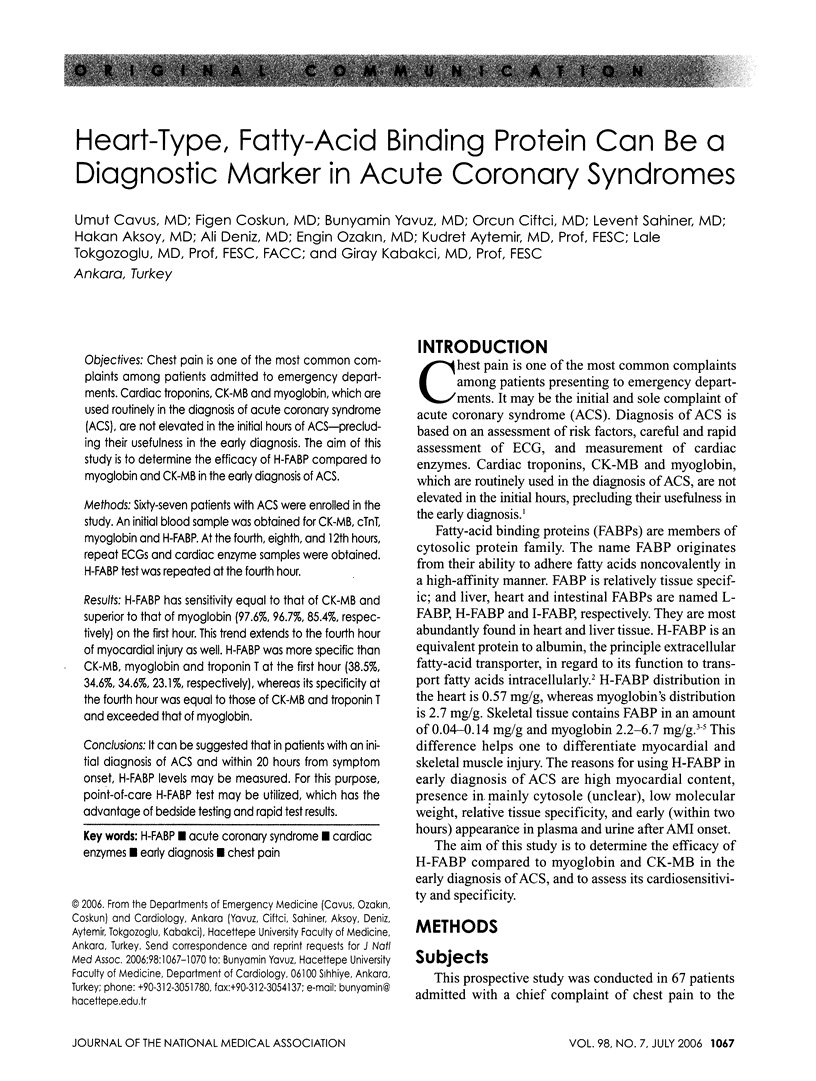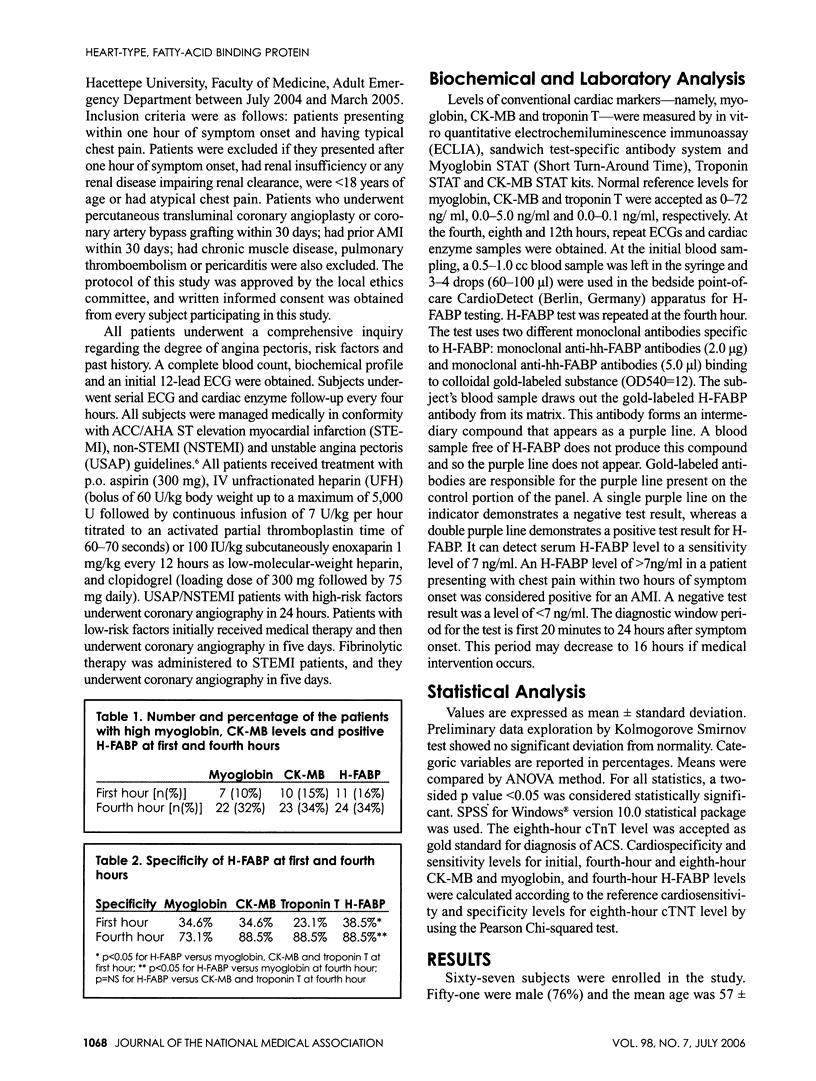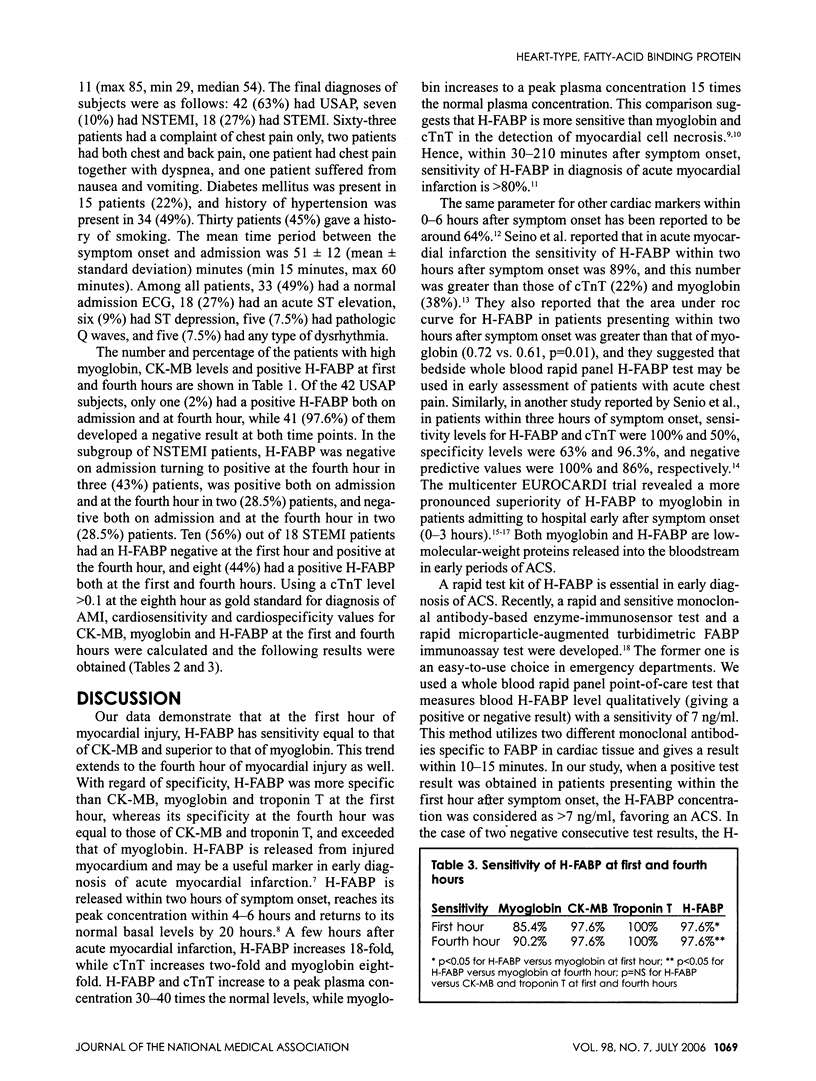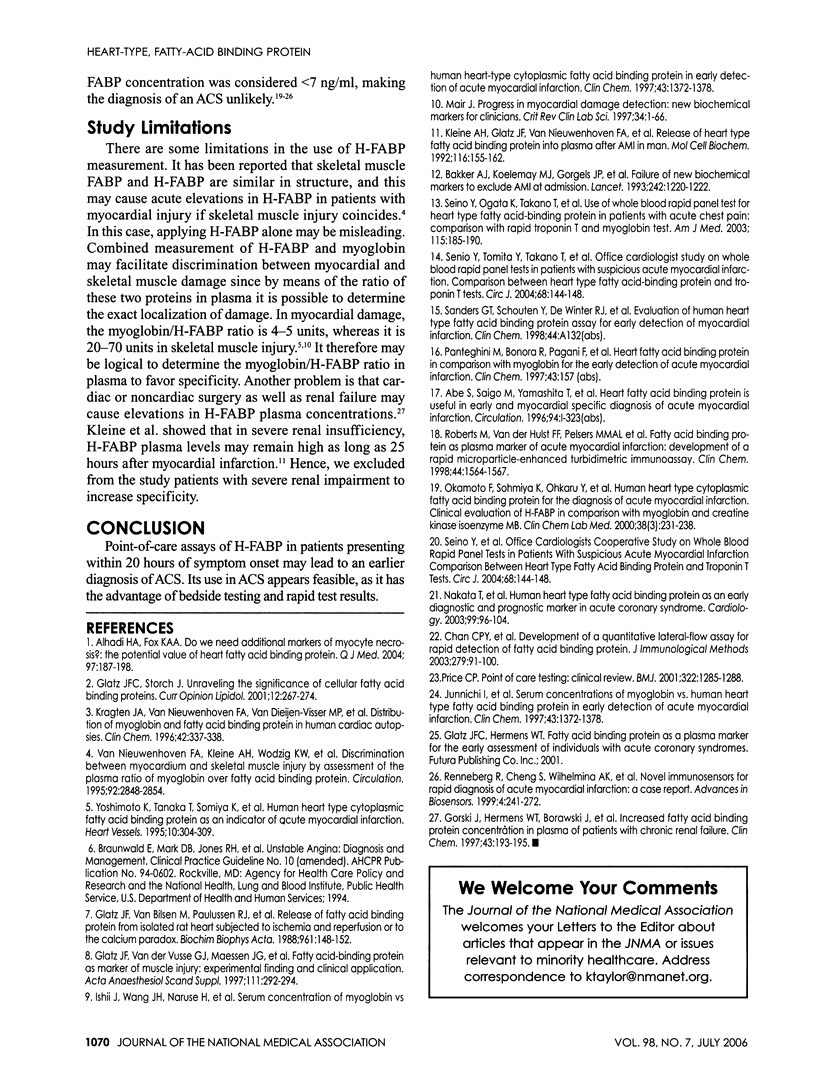Abstract
OBJECTIVES: Chest pain is one of the most common complaints among patients admitted to emergency departments. Cardiac troponins, CK-MB and myoglobin, which are used routinely in the diagnosis of acute coronary syndrome (ACS), are not elevated in the initial hours of ACS--precluding their usefulness in the early diagnosis. The aim of this study is to determine the efficacy of H-FABP compared to myoglobin and CK-MB in the early diagnosis of ACS. METHODS: Sixty-seven patients with ACS were enrolled in the study. An initial blood sample was obtained for CK-MB, cTnT, myoglobin and H-FABP. At the fourth, eighth, and 12th hours, repeat ECGs and cardiac enzyme samples were obtained. H-FABP test was repeated at the fourth hour. RESULTS: H-FABP has sensitivity equal to that of CK-MB and superior to that of myoglobin (97.6%, 96.7%, 85.4%, respectively) on the first hour. This trend extends to the fourth hour of myocardial injury as well. H-FABP was more specific than CK-MB, myoglobin and troponin T at the first hour (38.5%, 34.6%, 34.6%, 23.1%, respectively), whereas its specificity at the fourth hour was equal to those of CK-MB and troponin T and exceeded that of myoglobin. CONCLUSIONS: It can be suggested that in patients with an initial diagnosis of ACS and within 20 hours from symptom onset, H-FABP levels may be measured. For this purpose, point-of-care H-FABP test may be utilized, which has the advantage of bedside testing and rapid test results.
Full text
PDF



Selected References
These references are in PubMed. This may not be the complete list of references from this article.
- 50th AACC Annual Meeting, Chicago, Illinois, USA. August 2-6, 1998. Abstracts. Clin Chem. 1998 Jun;44(6 Pt 2):A1–188. [PubMed] [Google Scholar]
- Alhadi H. A., Fox K. A. A. Do we need additional markers of myocyte necrosis: the potential value of heart fatty-acid-binding protein. QJM. 2004 Apr;97(4):187–198. doi: 10.1093/qjmed/hch037. [DOI] [PubMed] [Google Scholar]
- Bakker A. J., Koelemay M. J., Gorgels J. P., van Vlies B., Smits R., Tijssen J. G., Haagen F. D. Failure of new biochemical markers to exclude acute myocardial infarction at admission. Lancet. 1993 Nov 13;342(8881):1220–1222. doi: 10.1016/0140-6736(93)92192-v. [DOI] [PubMed] [Google Scholar]
- Ferguson J. J. American College of Cardiology 45th Annual Scientific Session, Orlando, Florida, March 24 to 27, 1996. Circulation. 1996 Jul 1;94(1):1–5. doi: 10.1161/01.cir.94.1.1. [DOI] [PubMed] [Google Scholar]
- Glatz J. F., Storch J. Unravelling the significance of cellular fatty acid-binding proteins. Curr Opin Lipidol. 2001 Jun;12(3):267–274. doi: 10.1097/00041433-200106000-00005. [DOI] [PubMed] [Google Scholar]
- Glatz J. F., Van der Vusse G. J., Maessen J. G., Van Dieijen-Visser M. P., Hermens W. T. Fatty acid-binding protein as marker of muscle injury: experimental findings and clinical application. Acta Anaesthesiol Scand Suppl. 1997;111:292–294. [PubMed] [Google Scholar]
- Glatz J. F., van Bilsen M., Paulussen R. J., Veerkamp J. H., van der Vusse G. J., Reneman R. S. Release of fatty acid-binding protein from isolated rat heart subjected to ischemia and reperfusion or to the calcium paradox. Biochim Biophys Acta. 1988 Jul 1;961(1):148–152. doi: 10.1016/0005-2760(88)90141-5. [DOI] [PubMed] [Google Scholar]
- Górski J., Hermens W. T., Borawski J., Mysliwiec M., Glatz J. F. Increased fatty acid-binding protein concentration in plasma of patients with chronic renal failure. Clin Chem. 1997 Jan;43(1):193–195. [PubMed] [Google Scholar]
- Ishii J., Wang J. H., Naruse H., Taga S., Kinoshita M., Kurokawa H., Iwase M., Kondo T., Nomura M., Nagamura Y. Serum concentrations of myoglobin vs human heart-type cytoplasmic fatty acid-binding protein in early detection of acute myocardial infarction. Clin Chem. 1997 Aug;43(8 Pt 1):1372–1378. [PubMed] [Google Scholar]
- Ishii J., Wang J. H., Naruse H., Taga S., Kinoshita M., Kurokawa H., Iwase M., Kondo T., Nomura M., Nagamura Y. Serum concentrations of myoglobin vs human heart-type cytoplasmic fatty acid-binding protein in early detection of acute myocardial infarction. Clin Chem. 1997 Aug;43(8 Pt 1):1372–1378. [PubMed] [Google Scholar]
- Kleine A. H., Glatz J. F., Van Nieuwenhoven F. A., Van der Vusse G. J. Release of heart fatty acid-binding protein into plasma after acute myocardial infarction in man. Mol Cell Biochem. 1992 Oct 21;116(1-2):155–162. doi: 10.1007/BF01270583. [DOI] [PubMed] [Google Scholar]
- Kragten J. A., van Nieuwenhoven F. A., van Dieijen-Visser M. P., Theunissen P. H., Hermens W. T., Glatz J. F. Distribution of myoglobin and fatty acid-binding protein in human cardiac autopsies. Clin Chem. 1996 Feb;42(2):337–338. [PubMed] [Google Scholar]
- Mair J. Progress in myocardial damage detection: new biochemical markers for clinicians. Crit Rev Clin Lab Sci. 1997;34(1):1–66. doi: 10.3109/10408369709038215. [DOI] [PubMed] [Google Scholar]
- Nakata Tomoaki, Hashimoto Akiyoshi, Hase Mamoru, Tsuchihashi Kazufumi, Shimamoto Kazuaki. Human heart-type fatty acid-binding protein as an early diagnostic and prognostic marker in acute coronary syndrome. Cardiology. 2003;99(2):96–104. doi: 10.1159/000069726. [DOI] [PubMed] [Google Scholar]
- Okamoto F., Sohmiya K., Ohkaru Y., Kawamura K., Asayama K., Kimura H., Nishimura S., Ishii H., Sunahara N., Tanaka T. Human heart-type cytoplasmic fatty acid-binding protein (H-FABP) for the diagnosis of acute myocardial infarction. Clinical evaluation of H-FABP in comparison with myoglobin and creatine kinase isoenzyme MB. Clin Chem Lab Med. 2000 Mar;38(3):231–238. doi: 10.1515/CCLM.2000.034. [DOI] [PubMed] [Google Scholar]
- Price C. P. Point of care testing. BMJ. 2001 May 26;322(7297):1285–1288. doi: 10.1136/bmj.322.7297.1285. [DOI] [PMC free article] [PubMed] [Google Scholar]
- Robers M., Van der Hulst F. F., Fischer M. A., Roos W., Salud C. E., Eisenwiener H. G., Glatz J. F. Development of a rapid microparticle-enhanced turbidimetric immunoassay for plasma fatty acid-binding protein, an early marker of acute myocardial infarction. Clin Chem. 1998 Jul;44(7):1564–1567. [PubMed] [Google Scholar]
- Seino Yoshihiko, Ogata Ken-ichi, Takano Teruo, Ishii Jun-ichi, Hishida Hitoshi, Morita Hiroshi, Takeshita Hitoshi, Takagi Yasushi, Sugiyama Hiroshi, Tanaka Takao. Use of a whole blood rapid panel test for heart-type fatty acid-binding protein in patients with acute chest pain: comparison with rapid troponin T and myoglobin tests. Am J Med. 2003 Aug 15;115(3):185–190. doi: 10.1016/s0002-9343(03)00325-5. [DOI] [PubMed] [Google Scholar]
- Seino Yoshihiko, Tomita Yoshifumi, Takano Teruo, Ohbayashi Kanji, Tokyo Rapid-Test Office Cardiologists (Tokyo-ROC) Study Office cardiologists cooperative study on whole blood rapid panel tests in patients with suspicious acute myocardial infarction: comparison between heart-type fatty acid-binding protein and troponin T tests. Circ J. 2004 Feb;68(2):144–148. doi: 10.1253/circj.68.144. [DOI] [PubMed] [Google Scholar]
- Seino Yoshihiko, Tomita Yoshifumi, Takano Teruo, Ohbayashi Kanji, Tokyo Rapid-Test Office Cardiologists (Tokyo-ROC) Study Office cardiologists cooperative study on whole blood rapid panel tests in patients with suspicious acute myocardial infarction: comparison between heart-type fatty acid-binding protein and troponin T tests. Circ J. 2004 Feb;68(2):144–148. doi: 10.1253/circj.68.144. [DOI] [PubMed] [Google Scholar]
- Yoshimoto K., Tanaka T., Somiya K., Tsuji R., Okamoto F., Kawamura K., Ohkaru Y., Asayama K., Ishii H. Human heart-type cytoplasmic fatty acid-binding protein as an indicator of acute myocardial infarction. Heart Vessels. 1995;10(6):304–309. doi: 10.1007/BF02911388. [DOI] [PubMed] [Google Scholar]


